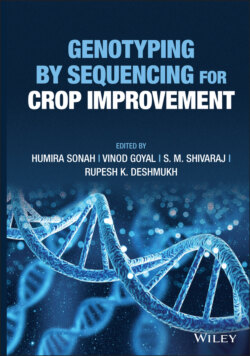Читать книгу Genotyping by Sequencing for Crop Improvement - Группа авторов - Страница 25
1.4.2 Identification of SNP in a Pregenomic Era
ОглавлениеInitially, identification of SNP markers was laborious and expensive and involved allele‐specific sequencing (Ganal et al. 2009). This includes sequencing of unigene‐derived amplicons using Sanger’s method from two or more than two lines. In an experiment, about 350 bp of the RFLP clone, A‐519 was end sequenced in soybean and the flanking amplification primers were designed (Coryell et al. 1999). Primers were used to screen for allele diversity using PCR from ten genotypes and the amplicons were sequenced followed by sequence comparison to identify SNP. SNPs were also identified through mining a large number of EST sequences in EST databases, which are generated through improved sequencing technologies (Soleimani et al. 2003). These SNPs are further validated using PCR (Batley et al. 2003). These approaches allowed the identification of mainly gene‐based SNPs, but their frequency is generally low. Additionally, SNPs located in low‐copy noncoding regions and intergenic spaces could not be identified.
Several assays have been developed for genotyping based on identified SNPs which include, allele‐specific hybridization, primer extension, oligonucleotide ligation, and invasive cleavage (Sobrino et al. 2005). Besides, DNA chips, allele‐specific PCR, and primer extension were also attractive options since these are suitable for automation and can be used for the development of dense genetic maps. Allele‐specific hybridization was used for the identification of polymorphism in 570 genotypes of soybean (Coryell et al. 1999).
